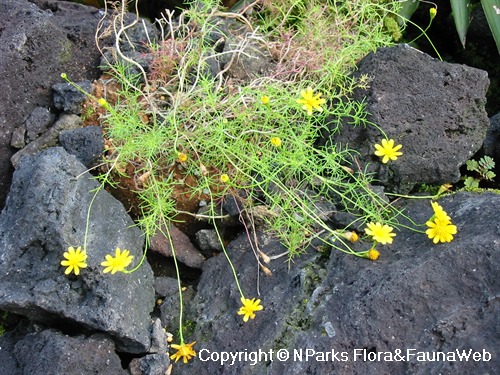
Back
Thymophylla tenuiloba
| Family Name: | Asteraceae (Compositae) |
| Synonyms: | Thymophylla tenuiloba var. tenuiloba, Dyssodia tenuiloba var. tenuiloba, Dyssodia tenuiloba |
| Common Name: | Dahlberg Daisy, Golden Fleece, Pricklyleaf, Shooting Star |
Name
Classifications and Characteristics
| Plant Division | Angiosperms (Flowering Seed Plants) (Dicotyledon) |
|---|---|
| Plant Growth Form | Creeper, Herbaceous Plant |
| Lifespan (in Singapore) | Perennial |
| Mode of Nutrition | Autotrophic |
| Maximum Height | 0.15 m to 0.30 m |
| Maximum Plant Spread / Crown Width | 0.3 m |
Biogeography
| Native Distribution | USA (Texas), northern Mexico |
|---|---|
| Native Habitat | Terrestrial (Grassland / Savannah/ Scrubland, Disturbed Area / Open Ground) |
| Preferred Climate Zone | Mediterranean, Desert / Arid |
Description and Ethnobotany
| Others - Plant Morphology | Herbaceous shrub, 0.15-0.30m height. Long trailing stems. Delicate looking.Leaves compound, leaflets threadlike, lacy, lobed, emit lemony scent when crushed. Inflorescence small, daisy-like, held on long stems; disk and ray flowers yellow. Attract butterflies. Seeds poisonous when consumed.Likes well-drained, sandy soils of pH 6.8 and above. Ideal as low edgings for borders, in planters and hanging baskets. Drought-tolerant, suitable for xeriscapes and rockeries.Under ideal planting conditions, plant self-seeds in immediate area. |
|---|
Landscaping Features
| Desirable Plant Features | Ornamental Flowers, Fragrant (Flowers, Foliage) (Time Independent) |
|---|---|
| Landscape Uses | Flowerbed / Border, Suitable for Hanging Baskets, Container Planting |
| Thematic Landscaping | Butterfly Garden, Rockery / Desert Garden, Naturalistic Garden, Wildflower Garden |
| Usage Hazard - Cons | Toxic Upon Ingestion |
| Usage Hazard - Cons Remarks | Seeds & parts of plant toxic when eaten. Handling leaves may cause contact allergy in certain individuals. |
| Plant & Rootzone Preference or Tolerance Remarks | Likes well-drained, sandy soils of pH 6.8 or higher. |
Fauna, Pollination and Dispersal
| Fauna Pollination Dispersal Associated Fauna | Butterfly-Attracting |
|---|---|
| Seed or Spore Dispersal | Biotic (Fauna) |
Plant Care and Propagation
| Light Preference | Full Sun |
|---|---|
| Water Preference | Moderate Water, Little Water |
| Plant Growth Rate | Moderate |
| Rootzone Tolerance | Well-Drained Soils, Alkaline high pH Soils, Drought Tolerant |
| Maintenance Requirements | Moderate |
| Propagation Method | Seed, Stem Cutting |
| Propagation Method Remarks | Plant normally self-seeds under ideal conditions (eg. when planted in well-drained, calcerous soils). |
Foliar
| Foliage Retention | Evergreen |
|---|---|
| Mature Foliage Colour(s) | Green |
| Mature Foliage Texture(s) | Thin |
| Foliar Modification | Reduced / Needle-like |
| Foliar Type | Simple / Unifoliate, Compound (Odd-Pinnate) |
| Foliar Arrangement Along Stem | Opposite |
| Foliar Shape(s) | Non-Palm Foliage (Linear) |
| Foliar Margin | Entire |
| Foliar Apex - Tip | Acuminate |
| Typical Foliar Area | Nanophyll ( 0.25cm2 - 2.25 cm2 ) |
Non - Foliar and Storage
| Stem Type & Modification | Herbaceous |
|---|---|
| Root Type | Underground (Fibrous Root) |
Floral (Angiosperm)
| Flower & Plant Sexuality | Bisexual Flowers |
| Flower Colour(s) | Yellow / Golden |
|---|---|
| Flower Symmetry | Radial |
| Flower Size - Remarks | Flower head 1.3cm across |
| Inflorescence Type | Head / Capitulum |
| Flowering Period | Free-Flowering |
| Flowering Opening Time | Time-Independent |
| Flowering Habit | Polycarpic |
Image Repository
Others
| Master ID | 1218 |
|---|---|
| Species ID | 2511 |
| Flora Disclaimer | The information in this website has been compiled from reliable sources, such as reference works on medicinal plants. It is not a substitute for medical advice or treatment and NParks does not purport to provide any medical advice. Readers should always consult his/her physician before using or consuming a plant for medicinal purposes. |
